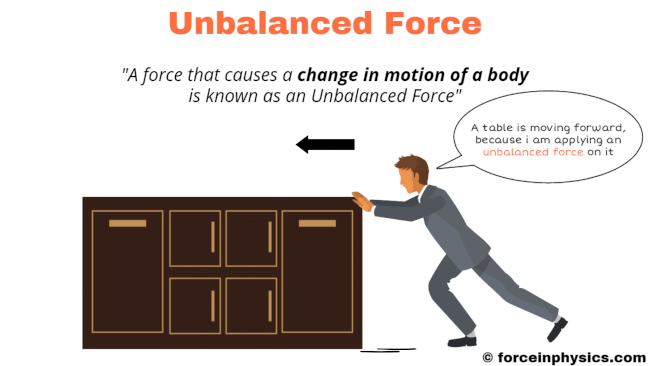
An unbalanced force, often encountered in everyday scenarios, is a force that leads to a change in an object’s motion. Unlike balanced forces, unbalanced forces do not offset or cancel each other out. Instead, they create a net force that acts on the object and causes it to accelerate or decelerate. For instance, when a person pushes a table lying on the floor, the force they apply is unbalanced as it exceeds the opposing forces like friction. Consequently, the table begins to move in the direction of the applied force. In this way, unbalanced forces disrupt the equilibrium of an object and produce a noticeable effect on its motion.
Examples
Football
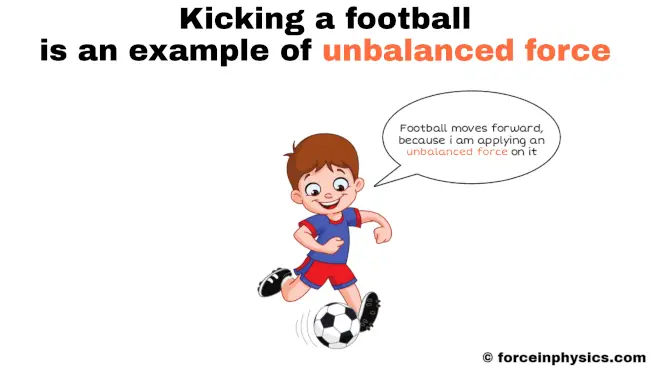
When an individual kicks a football, the force exerted by their leg on the ball acts as an unbalanced force and initiates the ball’s motion. The force of the kick overcomes the ball’s initial state of rest and propels it forward in the direction of the kick. As a result of this unbalanced force, the football starts moving, illustrating the concept of unbalanced forces causing a change in the object’s motion.
Trolley

When a person pulls a heavy luggage trolley, an unbalanced force is at play. Unbalanced forces arise when the net force acting on an object is non-zero, leading to changes in motion. As the person exerts force on the trolley to move it, this applied force becomes unbalanced, resulting in acceleration. The trolley will accelerate if the force applied by the person is greater than the opposing forces, such as friction and air resistance. On the other hand, if the opposing forces outweigh the applied force, the trolley will decelerate or come to a stop. This example illustrates how unbalanced forces cause objects to change their motion when external forces are not in equilibrium.
Seesaw
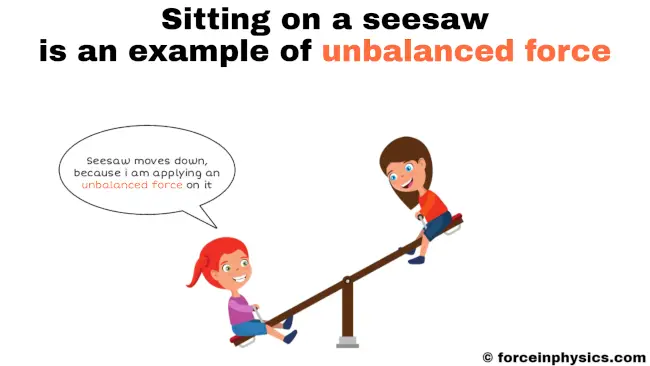
A seesaw perfectly illustrates the concept of unbalanced force. When two individuals of different weights sit on each end, an imbalance of forces occurs. The side with the heavier person exerts a stronger downward force, causing that end to lower while the other end rises. This unequal distribution of forces results in an unbalanced force and leads to the dynamic motion of the seesaw. The seesaw continues to tilt until the forces become balanced or until an external force comes into play. This example demonstrates how unbalanced forces cause objects to move when opposing forces are not in equilibrium, creating an exciting playtime experience on the seesaw.
Sliding book
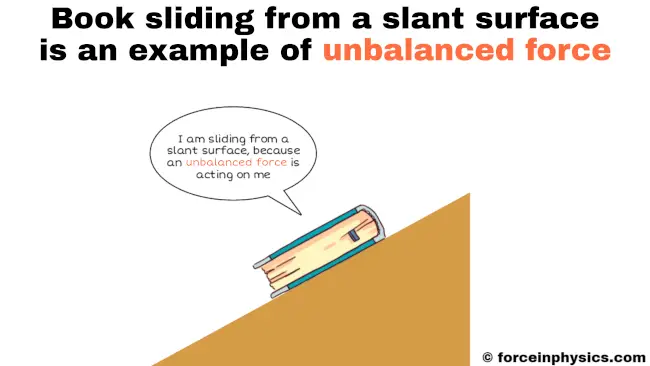
When a book is placed on a slanted surface, it experiences an unbalanced force that initiates the sliding motion. This unbalanced force arises from the difference in the magnitudes of the forces acting on the book. On a flat surface, the book remains in equilibrium, with the upward force equaling the downward force of gravity. However, on a slanted surface, the downward force becomes stronger and surpasses the upward force. Consequently, the book starts to slide as the unbalanced force disrupts the balance between the opposing forces. This sliding motion serves as a clear demonstration of how an unbalanced force affects the book’s behavior when placed on a slant.
Accelerating car
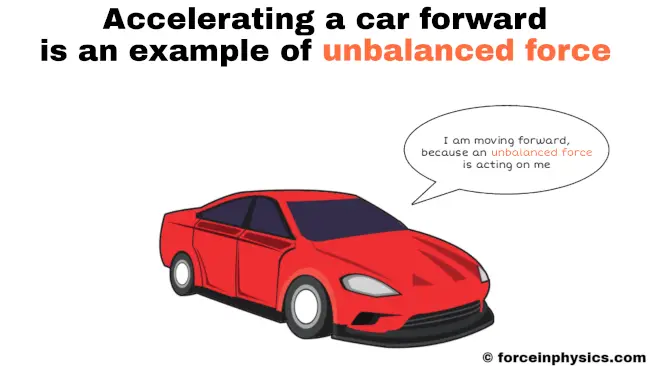
When a car accelerates forward, it encounters an unbalanced force that propels its motion. Before acceleration, the car remains balanced, with the upward force (from the ground) and the downward force (gravity) in equilibrium. However, as the engine starts, it exerts a force on the car in the forward direction. This force overtakes the opposing forces, disrupting the equilibrium and causing the car to accelerate. Hence, the unbalanced force generated by the engine enables the car’s acceleration and showcases the impact of unbalanced forces on an object’s motion.
Wooden block

When exerting force on a wooden block, causing it to move forward, the occurrence of an unbalanced force is evident. Initially, the wooden block remains in a state of equilibrium, with upward and downward forces counteracting each other, thus keeping it stationary. However, once an external force is applied to the block, it experiences a slight forward movement, which indicates the presence of an unbalanced force. This unbalanced force disrupts the equilibrium and initiates the block’s motion in the direction of the applied force. Hence, the movement of the wooden block demonstrates the impact of an unbalanced force on its motion.
Related
- Balanced force
- Unbalanced force
- Friction
- Tension (physics)
- Applied force
- Normal force
- Drag (physics)
- Gravity
- Centripetal force
- Centrifugal force
- Buoyancy
- Net force
- Compression (physics)
More topics
External links
- What Are Balanced and Unbalanced Forces? – Roma Independent School District
- Balanced vs. Unbalanced Forces – The Physics Classroom
- Unbalanced Force: Definition & Example – Study.com
- Balanced and unbalanced forces – California State University, Northridge
- Balanced vs Unbalanced Forces – Weebly
- Motion: Balanced and Unbalanced Forces – Turito
- How are unbalanced forces even possible, given Newton’s 3rd law? – Physics Stack Exchange
- Balanced & Unbalanced Forces | Reading Material – Niagara Falls City School District
- Investigate how unbalanced forces affect an object’s motion – Varsity Tutors
- MECHANICS (MOTION) / UNBALANCED FORCES – Pathwayz
- Unbalanced Force: Definition, Examples, and Equation – Science Facts
- Balanced and Unbalanced Forces – TeachPE.com
- Balanced and unbalanced forces – BBC
- Balanced and Unbalanced Forces – Labster Theory
- Newton’s First Law: Inertia and Unbalanced Forces – NASA (.gov)
- What is a Unbalanced Force? – Sciencing
- What Happens When Forces Are Balanced or Unbalanced? – Woodstown-Pilesgrove Regional School District
- Unbalanced Forces – Shalom Education
- 5th Grade Science – Balanced and Unbalanced Forces – Mesa Distance Learning Program
- Balanced & Unbalanced Forces – Physics Fox
- Net or Unbalanced Forces – National Science Teachers Association
- Junior physics-Unbalanced forces – Dynamic Science
- Flexi answers – What is an unbalanced force? – CK-12 Foundation
- What are Balanced and Unbalanced Forces? A Guide for Young Scientists – Science Times
Deep
Forceinphysics.com was founded by Deep Rana, who is a mechanical engineer by profession and a blogger by passion. He has a good conceptual knowledge on different educational topics and he provides the same on this website. He loves to learn something new everyday and believes that the best utilization of free time is developing a new skill.
